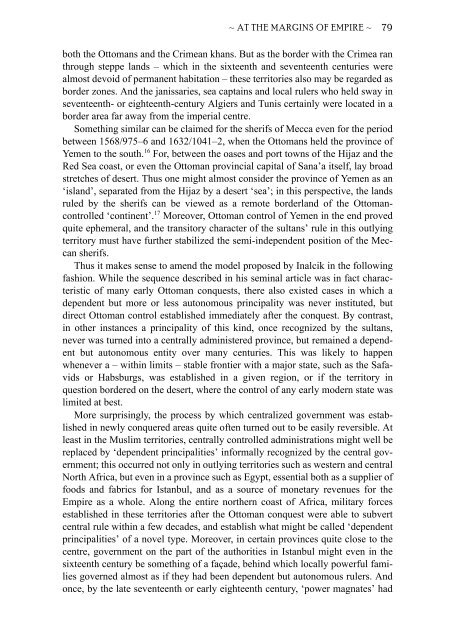The Ottoman Empire and the World Around It - Course Information
The Ottoman Empire and the World Around It - Course Information
The Ottoman Empire and the World Around It - Course Information
You also want an ePaper? Increase the reach of your titles
YUMPU automatically turns print PDFs into web optimized ePapers that Google loves.
~ AT THE MARGINS OF EMPIRE ~ 79<br />
both <strong>the</strong> <strong>Ottoman</strong>s <strong>and</strong> <strong>the</strong> Crimean khans. But as <strong>the</strong> border with <strong>the</strong> Crimea ran<br />
through steppe l<strong>and</strong>s – which in <strong>the</strong> sixteenth <strong>and</strong> seventeenth centuries were<br />
almost devoid of permanent habitation – <strong>the</strong>se territories also may be regarded as<br />
border zones. And <strong>the</strong> janissaries, sea captains <strong>and</strong> local rulers who held sway in<br />
seventeenth- or eighteenth-century Algiers <strong>and</strong> Tunis certainly were located in a<br />
border area far away from <strong>the</strong> imperial centre.<br />
Something similar can be claimed for <strong>the</strong> sherifs of Mecca even for <strong>the</strong> period<br />
between 1568/975–6 <strong>and</strong> 1632/1041–2, when <strong>the</strong> <strong>Ottoman</strong>s held <strong>the</strong> province of<br />
Yemen to <strong>the</strong> south. 16 For, between <strong>the</strong> oases <strong>and</strong> port towns of <strong>the</strong> Hijaz <strong>and</strong> <strong>the</strong><br />
Red Sea coast, or even <strong>the</strong> <strong>Ottoman</strong> provincial capital of Sana’a itself, lay broad<br />
stretches of desert. Thus one might almost consider <strong>the</strong> province of Yemen as an<br />
‘isl<strong>and</strong>’, separated from <strong>the</strong> Hijaz by a desert ‘sea’; in this perspective, <strong>the</strong> l<strong>and</strong>s<br />
ruled by <strong>the</strong> sherifs can be viewed as a remote borderl<strong>and</strong> of <strong>the</strong> <strong>Ottoman</strong>controlled<br />
‘continent’. 17 Moreover, <strong>Ottoman</strong> control of Yemen in <strong>the</strong> end proved<br />
quite ephemeral, <strong>and</strong> <strong>the</strong> transitory character of <strong>the</strong> sultans’ rule in this outlying<br />
territory must have fur<strong>the</strong>r stabilized <strong>the</strong> semi-independent position of <strong>the</strong> Meccan<br />
sherifs.<br />
Thus it makes sense to amend <strong>the</strong> model proposed by Inalcik in <strong>the</strong> following<br />
fashion. While <strong>the</strong> sequence described in his seminal article was in fact characteristic<br />
of many early <strong>Ottoman</strong> conquests, <strong>the</strong>re also existed cases in which a<br />
dependent but more or less autonomous principality was never instituted, but<br />
direct <strong>Ottoman</strong> control established immediately after <strong>the</strong> conquest. By contrast,<br />
in o<strong>the</strong>r instances a principality of this kind, once recognized by <strong>the</strong> sultans,<br />
never was turned into a centrally administered province, but remained a dependent<br />
but autonomous entity over many centuries. This was likely to happen<br />
whenever a – within limits – stable frontier with a major state, such as <strong>the</strong> Safavids<br />
or Habsburgs, was established in a given region, or if <strong>the</strong> territory in<br />
question bordered on <strong>the</strong> desert, where <strong>the</strong> control of any early modern state was<br />
limited at best.<br />
More surprisingly, <strong>the</strong> process by which centralized government was established<br />
in newly conquered areas quite often turned out to be easily reversible. At<br />
least in <strong>the</strong> Muslim territories, centrally controlled administrations might well be<br />
replaced by ‘dependent principalities’ informally recognized by <strong>the</strong> central government;<br />
this occurred not only in outlying territories such as western <strong>and</strong> central<br />
North Africa, but even in a province such as Egypt, essential both as a supplier of<br />
foods <strong>and</strong> fabrics for Istanbul, <strong>and</strong> as a source of monetary revenues for <strong>the</strong><br />
<strong>Empire</strong> as a whole. Along <strong>the</strong> entire nor<strong>the</strong>rn coast of Africa, military forces<br />
established in <strong>the</strong>se territories after <strong>the</strong> <strong>Ottoman</strong> conquest were able to subvert<br />
central rule within a few decades, <strong>and</strong> establish what might be called ‘dependent<br />
principalities’ of a novel type. Moreover, in certain provinces quite close to <strong>the</strong><br />
centre, government on <strong>the</strong> part of <strong>the</strong> authorities in Istanbul might even in <strong>the</strong><br />
sixteenth century be something of a façade, behind which locally powerful families<br />
governed almost as if <strong>the</strong>y had been dependent but autonomous rulers. And<br />
once, by <strong>the</strong> late seventeenth or early eighteenth century, ‘power magnates’ had


